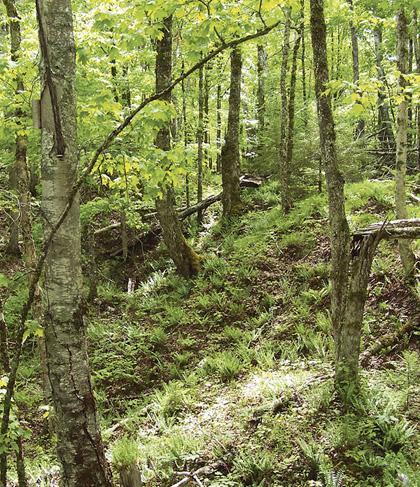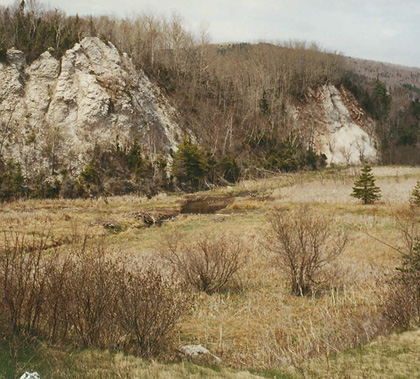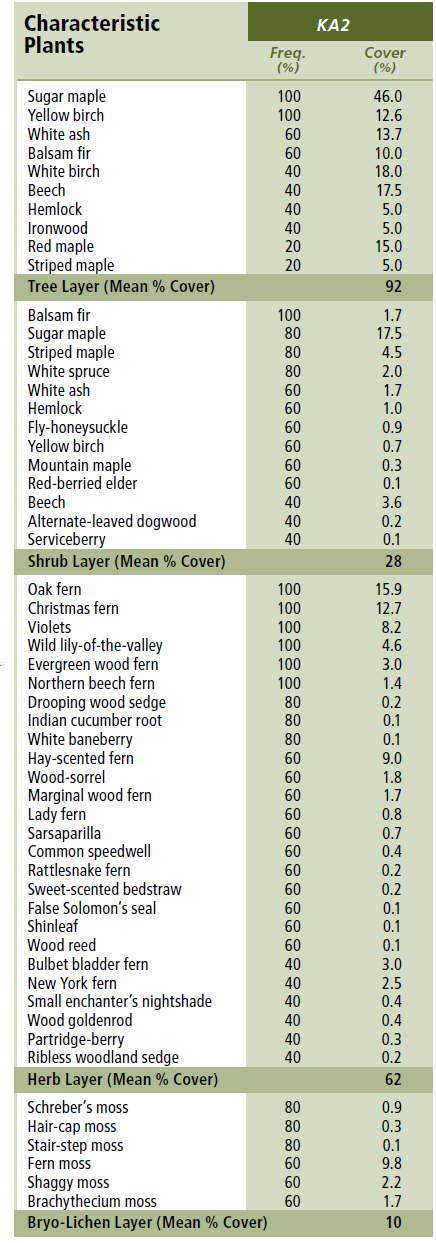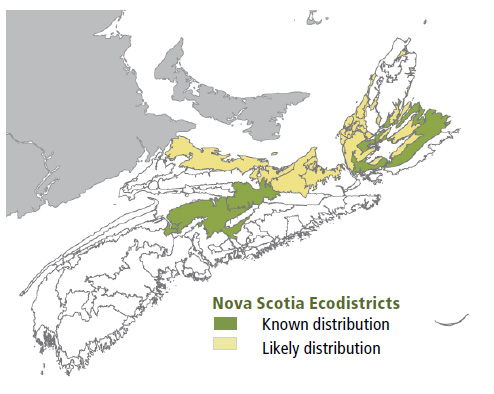
Forest Vegetation types - KA2
KA2 — Sugar maple / Christmas fern – Rattlesnake fern – Bulblet bladder fern
Acer saccharum / Polystichum acrostichoides –
Botrychium virginianum – Cystopteris bulbifera
 |
Brookfield, Colchester County |
Concept: The Sugar maple / Christmas fern - Rattlesnake fern - Bulblet bladder fern forest is distinguished from other provincial forests by its unique site conditions, overstory composition, and by the presence of understory plants locally associated with karst topography. This late successional Vegetation Type (VT) has an overstory dominated by sugar maple with lesser yellow birch, beech and white ash. These long-lived and shade-tolerant trees will develop old forest characteristics, maintained by gap disturbances.
Vegetation: The canopy supports moderate to high crown closure and is usually dominated by sugar maple. Beech, yellow birch /or white birch can be locally abundant, while white ash and balsam fir are somewhat frequent but occur with reduced cover. The understory supports low to moderate levels of woody and bryophyte species but higher herbaceous cover. Characteristic plants include striped maple, round-leaved dogwood, oak fern, Christmas fern, white baneberry and marginal wood fern. Plant species commonly associated with karst are not frequent in plot data because most of these species are sparse across broader karst landscapes, particularly where soils are deeper and nutrient enrichment is weakened.
Environmental Setting: KA2 is associated with fresh to moist, nutrient medium to rich soils found in karst landscapes. These landscapes are typically rugged with scattered bedrock exposures and steep sided sinkholes. This VT is mainly found in the Central Lowlands and Bras d'Or Lowlands ecodistricts. KA2 occurs at low elevation on karst flats, short slopes and shallow depressions; microtopography is moderate. Rooting potential can be strongly limited by shallow surficial deposits. This VT occurs in southern New Brunswick but is very uncommon. It is absent from Prince Edward Island.
Successional Dynamics: KA2 is a late successional, uneven-aged VT dominated by sugar maple. Excluding harvesting, stand-level disturbance events are rare with gaps or small patches usually created by individual tree mortality, wind, ice damage or karst processes. Bedrock dissolution, sinkhole formation and soil erosion, and subsidence are common ecosystem processes in karst landscapes. Where stand-level disturbances have occurred, potential early successional VTs include IH4 (Trembling aspen / Wild raisin / Bunchberry) and IH6 (White birch – Red maple / Sarsaparilla – Bracken). In areas where deeper till deposits occur over calcium-enriched bedrock, TH8 (Red maple – Yellow birch / Striped maple) may be found in conjunction with KA2 stands.
Ecological Features: This VT occurs as a small to large patch in areas where glacial tills are underlain by calcareous bedrock. This uncommon closed canopy community supports many rare plants, including yellow and ram's head lady's slippers and leatherwood. Ram's head lady's slipper is legally protected and listed as endangered under the Nova Scotia Endangered Species Act. Most karst in Nova Scotia develops over gypsum deposits forming rugged landforms with funnel shaped sinkholes, subterranean caves and tunnels. Caves may be used by porcupine, creating unique cave faunal communities associated with porcupine dung. Larger caves, some up to several hundred meters deep, may also provide important winter hibernacula for bats. Karst landscapes contain a diverse mix of habitats ranging from dry hill crests and actively collapsing sinkholes to small alkaline ponds and wetlands. Their calcareous soils support the greatest diversity of land snails in the Province. Gypsum and limestone quarrying, which are common in areas of Nova Scotia karst, has detrimental impacts on biodiversity.
 |
| Gypsum cliff, Mabou Harbour |
Distinguishing Features: This is a broadly defined hardwood forest occurring on karst topography. Sugar maple is usually the dominant overstory species, but depending on past disturbances and successional stage other species such as yellow birch, beech, white ash, white birch and red maple may be present.
| Slope Position: | Upper4 Crest2 Lower2 Middle2 |
Surface Stoniness: |
(Non - Slightly)10 |
Bedrock Outcrop: |
(Non-rocky)4 (Slightly - Moderately)4 (Very - Excessively)2 |
Elevation Range: |
13 - 80m |
Slope Gradient: |
Moderate4 Steep4 nd2 |
Aspect: |
North4 South2 West2 None2 |
Exposure: |
Moderate8 Sheltered2 |
Microtopography: |
Moderately8 Slightly2 |
Drainage: |
Moderately well4 Well4 Imperfect2 |
Soil Type: |
ST114 ST52 ST122 ST15-L2 |
Parent Material: |
Glacial till8 Colluvium2 |
Rooting Depth (cm): |
(<30)2 (30-45)2 (>45)4 nd2 |
Duff Thickness (cm): |
(0-5)6 (6-10)2 nd2 |

